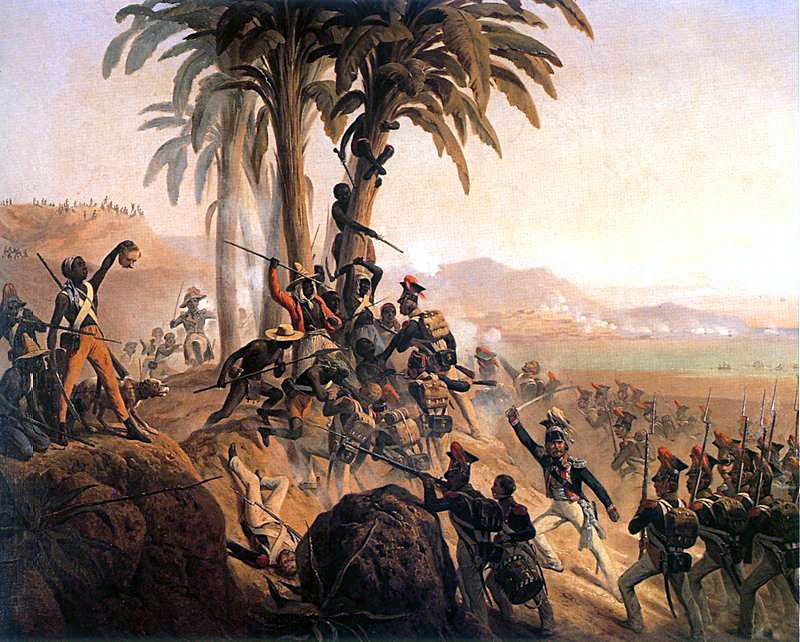In 1789, Haiti was known as Saint-Domingue. It was a French colony, which through the brutal application of slave labor had become responsible for producing 60% of the world’s coffee and 40% of the world’s sugar, effectively making the slave owners in Haiti very, very wealthy men.
In 1789, there were 32,000 whites that lived in Haiti; 28,000 mulattoes and free blacks but there were a whopping 425,000 enslaved Africans. When you’re surrounded 13 to 1 by people you are keeping against their will there is really only one way to maintain any semblance of control and that is with a steady, merciless diet of heaping portions of violence or at least the threat of violence.
Well, you know what they say; you are what you eat…
Although the drive to push slave labor was brutal everywhere, Haiti was unique in that the French had a callous willingness to literally work enslaved Africans to DEATH. In fact, after the rebellion, when most of the French slave-owners fled Haiti and resettled in Louisiana they brought with them their proclivity for leveraging violence to drive productivity; as a result, life expectancy was lower for enslaved Africans in Louisiana than any other state in the union.
It was because of the willingness of the French slave owners to work their slaves literally to death that 2/3s of all of the slaves in Haiti were African-born. That’s right. 2/3s of the enslaved African populations were born free in Africa. See a problem yet? To maintain the inconceivable level of productivity necessary to produce 60% of the world’s coffee and 40% of the world’s sugar placed a premium value on enslaved African men, which over time tipped the male/female ratio among enslaved Africans so out of whack that Haiti had become a sausage fest. All of this contributed to enslaved Africans in Haiti being far less submissive than enslaved Africans in America who tended to be multigenerational slaves who, sadly, didn’t know anything but slavery. So while the insatiable greed of slave owners was practically universal across the board, this willingness to work their enslaved Africans to death in Haiti made it necessary for slave owners to regularly return to Africa and bring unseasoned Africans back to Haiti to work their fields.
So the slave revolt, which would go down in history as the most successful slave revolt in recorded history, began in April of 1791 and ended in November of 1803 with the French being defeated at the Battle of Vertières. Haiti, the first and only State that came into existence as the result of a slave rebellion became an independent country on January 1, 1804 just two months later. Upon declaring independence from France, Saint-Domingue was renamed Haiti because Haiti was the name that the indigenous people called their island.
The response from the United States government was interesting albeit predictable.
American Conservatives sympathies lay with the slave owners and urged the United States government to send money to help suppress the rebellion in Saint-Domingue. (Haiti)
American Progressives in the North argued that supporting slave-owners who were oppressing the freedom of others was not only hypocritical but also inconsistent with “American values” and the principles that they had fought in their own American revolution against the British and demanded that they support the rebellion.
These newly liberated Haitians were not messing around. They founded the Republic of Haiti in January and by February, on the orders of Jean-Jacques Dessalines, a former slave and first ruler under the Haitian constitution, these newly liberated Africans began mercilessly killing most white Haitians that hadn’t fled the island. In fact, in only a mere three months, from February 1804 until 22 April 1804 3,000 to 5,000 whites Haitians had been murdered.
Ironically, because the male\female ratio was so out of whack on the island one of the few groups that were spared during this massacre were White Haitian women on the condition that they agreed (under duress) to marry a Haitian man. I have no doubt that the rapes were incalculable.
Jean-Jacques Dessalines justified the massacres as payback for years of atrocities enslaved Africans faced under the institution of slavery in Haiti. By the end of April 1804 there were practically no White Haitians left on the island. Those who hadn’t been killed had fled to Louisiana which had been owned by the French just the year before.
After losing Saint-Domingue, the French returned with warships and parked them just off shore and threatened to resume war against the young Republic if the new Republic didn’t work out some arrangement to pay reparations to the French slaveholders for their lost land and property. Notice I separated land from property because Haitians were the property that they were expected to pay for. The French said that they owed reparations to these former slave owners to the tune of 150 million francs. Of course the new Haitian government didn’t have that kind of money. But living under the constant threat of returning to war Haitian President Jean-Pierre Boyer, agreed to pay reparations to the tune of 60 million francs in 1838 in exchange for French recognition of its independence. The problem though was Haiti didn’t have 60 million either, but the French, being good and fair people, agreed to loan them the 60 million, with interest.
Let’s put that amount of money in perspective. The year before, in 1803 Thomas Jefferson finalized the Louisiana Purchase from the French. The United States had purchased some 828,000 square miles of land from the French for only 50 million francs.
For 50 million francs the United States bought all of Arkansas, Missouri, Iowa, Oklahoma, Kansas, and Nebraska; parts of Minnesota, most of North Dakota; most of South Dakota; northeastern New Mexico; northern Texas; portions of Montana, Wyoming, and eastern Colorado and all of Louisiana west of the Mississippi River, including the city of New Orleans.
So the initial amount France demanded to be repaid by these former Haitian slaves was three times what they charged the United States for selling it enough land to double her size and make the United States one of the largest countries in the World.
The result was that this “deal” to avoid war bankrupted the Haitian treasury effectively dooming the island to be the poorest nation in the Western Hemisphere which continues to be the case to this day. Here was an island that had produced 60% of the world’s coffee and 40% of the world’s sugar and made insane amounts of wealth for slavers, now buried under crushing debt, killing its ability to benefit at all from cultivating the same kind of wealth for themselves that their owners had done exploiting them.
It took Haiti 122 years to pay back restitution to France for winning their freedom. Haiti made its last payment to France, for the loan it took to reimburse the slave owners for owning them, in 1947. So while the United States is off fighting Nazis and dropping Atomic Bombs on Japan, the Haitian people are still paying off a loan to reimburse their slave owners.
In 2010 Pat Robertson made a public statement that the reason Haiti was hit with such a terrible earthquake on Tuesday, 12 January 2010 was because the leaders of the slave revolt in 1804 made a “pact to the devil” to gain their independence. Remember, 2/3s of these enslaved Africans on the island of Haiti were African born. They were NOT Christians (a topic I will explore in depth later). These enslaved Africans practiced their traditional indigenous African religions. They did not seek strength from “Christ” to bring them victory over their slave-owners, they were asking for that strength from their own ancestors and Gods. It was the opinion of Pat Robertson that this earthquake was God paying them back.

